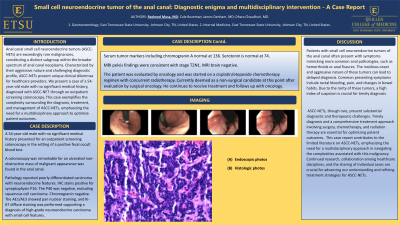Tuesday Poster Session
Category: Colon
P3682 - Small Cell Neuroendocrine Tumor of the Anal Canal - Diagnostic Enigma and Multidisciplinary Intervention: A Case Report
Tuesday, October 29, 2024
10:30 AM - 4:00 PM ET
Location: Exhibit Hall E

Has Audio

Rasheed Musa, MD
East Tennessee State University
Johnson City, TN
Presenting Author(s)
Rasheed Musa, MD, Parth Goenka, , Cole Bozeman, , James Denham, MD, Dhara Chaudhari, MD
East Tennessee State University, Johnson City, TN
Introduction: Anal canal small cell neuroendocrine tumors (ASCC-NETs) are exceedingly rare malignancies, constituting a distinct subgroup within the broader spectrum of anal canal neoplasms. Characterized by their aggressive nature and challenging diagnostic profile, ASCC-NETs present unique clinical dilemmas for healthcare providers. We present a case of a 54-year-old male with no significant medical history, diagnosed with ASCC-NET through an outpatient screening colonoscopy. This case exemplifies the complexity surrounding the diagnosis, treatment, and management of ASCC-NETs, emphasizing the need for a multidisciplinary approach to optimize patient outcomes.
Case Description/Methods: A 54-year-old male with no significant medical history presented for an outpatient screening colonoscopy in the setting of a positive fecal occult blood test.
A colonoscopy was remarkable for an ulcerated non-obstructive mass of malignant appearance was found in the anal canal.
Pathology reported poorly differentiated carcinoma with neuroendocrine features. IHC stains positive for synaptophysin P16. The P40 was negative, excluding squamous cell carcinoma. Chromogranin negative. The AE1/AE3 showed pan nuclear staining, and Ki-67 diffuse staining was performed supporting a diagnosis of high-grade neuroendocrine carcinoma with small cell features.
Serum tumor markers including chromogranin A normal at 136. Serotonin is normal at 74.
MRI pelvis findings were consistent with stage T2N1. MRI brain negative.
The patient was evaluated by oncology and was started on a cisplatin/etoposide chemotherapy regimen with concurrent radiotherapy. Currently deemed as a non-surgical candidate at this point after evaluation by surgical oncology. He continues to receive treatment and follows up with oncology.
Discussion: Patients with small cell neuroendocrine tumors of the anal canal often present with symptoms mimicking more common anal pathologies, such as hemorrhoids or anal fissures. The insidious onset and aggressive nature of these tumors can lead to delayed diagnosis. Common presenting symptoms include rectal bleeding, pain, and changes in bowel habits. Due to the rarity of these tumors, a high index of suspicion is crucial for timely diagnosis.

Disclosures:
Rasheed Musa, MD, Parth Goenka, , Cole Bozeman, , James Denham, MD, Dhara Chaudhari, MD. P3682 - Small Cell Neuroendocrine Tumor of the Anal Canal - Diagnostic Enigma and Multidisciplinary Intervention: A Case Report, ACG 2024 Annual Scientific Meeting Abstracts. Philadelphia, PA: American College of Gastroenterology.
East Tennessee State University, Johnson City, TN
Introduction: Anal canal small cell neuroendocrine tumors (ASCC-NETs) are exceedingly rare malignancies, constituting a distinct subgroup within the broader spectrum of anal canal neoplasms. Characterized by their aggressive nature and challenging diagnostic profile, ASCC-NETs present unique clinical dilemmas for healthcare providers. We present a case of a 54-year-old male with no significant medical history, diagnosed with ASCC-NET through an outpatient screening colonoscopy. This case exemplifies the complexity surrounding the diagnosis, treatment, and management of ASCC-NETs, emphasizing the need for a multidisciplinary approach to optimize patient outcomes.
Case Description/Methods: A 54-year-old male with no significant medical history presented for an outpatient screening colonoscopy in the setting of a positive fecal occult blood test.
A colonoscopy was remarkable for an ulcerated non-obstructive mass of malignant appearance was found in the anal canal.
Pathology reported poorly differentiated carcinoma with neuroendocrine features. IHC stains positive for synaptophysin P16. The P40 was negative, excluding squamous cell carcinoma. Chromogranin negative. The AE1/AE3 showed pan nuclear staining, and Ki-67 diffuse staining was performed supporting a diagnosis of high-grade neuroendocrine carcinoma with small cell features.
Serum tumor markers including chromogranin A normal at 136. Serotonin is normal at 74.
MRI pelvis findings were consistent with stage T2N1. MRI brain negative.
The patient was evaluated by oncology and was started on a cisplatin/etoposide chemotherapy regimen with concurrent radiotherapy. Currently deemed as a non-surgical candidate at this point after evaluation by surgical oncology. He continues to receive treatment and follows up with oncology.
Discussion: Patients with small cell neuroendocrine tumors of the anal canal often present with symptoms mimicking more common anal pathologies, such as hemorrhoids or anal fissures. The insidious onset and aggressive nature of these tumors can lead to delayed diagnosis. Common presenting symptoms include rectal bleeding, pain, and changes in bowel habits. Due to the rarity of these tumors, a high index of suspicion is crucial for timely diagnosis.

Figure: Anal NET endo and histo
Disclosures:
Rasheed Musa indicated no relevant financial relationships.
Parth Goenka indicated no relevant financial relationships.
Cole Bozeman indicated no relevant financial relationships.
James Denham indicated no relevant financial relationships.
Dhara Chaudhari indicated no relevant financial relationships.
Rasheed Musa, MD, Parth Goenka, , Cole Bozeman, , James Denham, MD, Dhara Chaudhari, MD. P3682 - Small Cell Neuroendocrine Tumor of the Anal Canal - Diagnostic Enigma and Multidisciplinary Intervention: A Case Report, ACG 2024 Annual Scientific Meeting Abstracts. Philadelphia, PA: American College of Gastroenterology.
